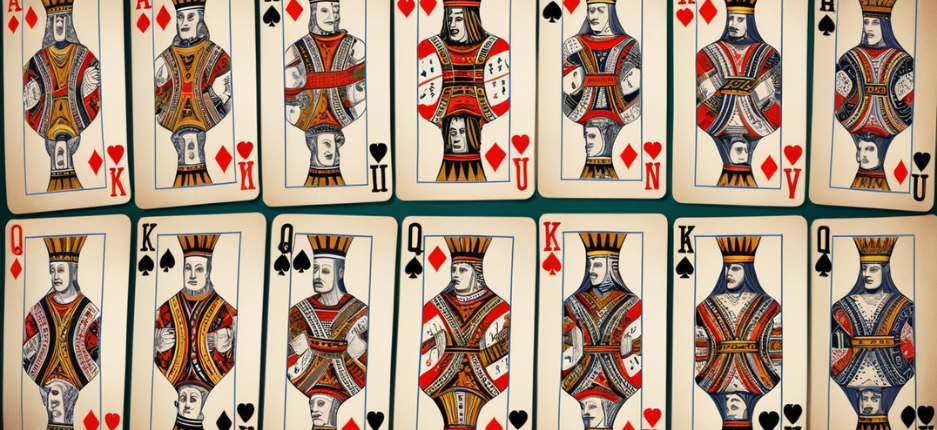In the exciting and thrilling world of poker, understanding the hierarchy of poker hand rankings is essential for every player aspiring to win the pot. After all, poker hand rankings are the key to unlocking the potential of your cards – guiding your decisions about folding at the right time to building a pot-winning hand. So, if you want to go from being a beginner to a poker shark, you need to have solid grasp of these rankings which will increase your chances of winning at the poker table.
This article will be your ultimate guide for mastering poker hand rankings. We will break down the hierarchy of poker cards from the unbeatable Royal Flush to the basic high card. In addition to that, we will also explain how to identify strong starting hands, navigate ties and make informed decisions. So lets get started.
The importance of knowing poker hand rankings

Knowing poker hand rankings is not just about bragging rights; it can greatly impact your decision-making during gameplay. By understanding the strength of your hand relative to your opponent’s hands, you can make informed choices about whether to bet, call, or fold.
This knowledge allows you to strategize wisely, maximizing your chances of winning and minimizing your losses. Here are some more reasons why you need to know poker hand rankings:
Make Informed Decisions
It allows you to assess the strength of your hand compared to what your opponents might have. This is vital for deciding whether to fold, call, raise, or even bluff. With a weak hand, you wouldn’t want to waste money by calling large bets. Conversely, a strong hand might warrant raising the stakes to pressure opponents or build the pot.
Recognize Winning Potential
Quickly identifying potential winning combinations in the cards you’re dealt is key. This lets you capitalize on strong hands and play them strategically.
Evaluate Opponent’s Actions
By understanding hand rankings, you can interpret your opponent’s betting patterns. Are they aggressively betting with a likely strong hand or bluffing with a weak one? Hand rankings provide the foundation for making these judgments.
Minimize Losses
It prevents you from clinging to weak hands and losing chips unnecessarily. Knowing when to fold a hand that statistically has a low chance of winning saves you money in the long run.
Bluffing Effectively
A good poker player understands how to use bluffs strategically. Knowing hand rankings helps you determine situations where a well-timed bluff might scare opponents away from a stronger hand.
Fair Play
Understanding hand rankings ensures everyone plays by the same set of rules. It creates a level playing field where the best hand wins, not just the luckiest draw.
Understanding the basic poker hand hierarchy

Before we delve into the specifics, let’s start by familiarizing ourselves with the basic poker hand hierarchy. In poker, the objective is to make the best five-card hand possible out of the seven cards available to you. The higher your hand ranks, the better your chances of winning the pot.
The Royal Flush – the highest hand in poker
Imagine the thrill of holding the highest-ranking hand in poker – the Royal Flush. This hand consists of the Ace, King, Queen, Jack, and Ten, all of the same suit. It is an unbeatable hand that guarantees victory. However, due to its rarity, hitting a Royal Flush is an extraordinary achievement that only a fortunate few can claim.
The Straight Flush – a powerful hand in poker
Next in line is the Straight Flush, a formidable hand that can lead you to victory. It comprises five consecutive cards of the same suit, such as 8, 9, 10, Jack, and Queen of hearts. While not as unbeatable as the Royal Flush, the Straight Flush is still an immensely strong hand that demands respect from your opponents.
Four of a Kind – a rare but strong hand in poker
Few hands can match the power of Four of a Kind. As the name suggests, this hand consists of four cards of the same rank, accompanied by any fifth card. For example, having four Aces and a King would give you Four of a Kind. This hand is relatively rare but can be a game-changer when it occurs.
Full House – a combination of three of a-kind and a pair
A Full House is a combination of three of a kind and a pair. It is formed by having three cards of the same rank, paired with two cards of another rank. For instance, if you have three Queens and two Kings, you have a Full House. This hand is powerful and often spells trouble for your opponents.
Flush – a hand with five cards of the same suit
When you have five cards of the same suit, regardless of their rank, you have a Flush. This hand showcases your ability to collect a cohesive set of cards and can be a strong contender at the poker table. However, if multiple players have a Flush, the player with the highest-ranking cards wins the pot.
Straight – a hand with five consecutive cards
The Straight is a hand that consists of five consecutive cards of any suit. For example, having 3, 4, 5, 6, and 7 would give you a Straight. It is worth noting that in poker, an Ace can be used as a high or low card, allowing for a Straight from Ace to 5 or from 10 to Ace. The Straight is a respectable hand that can give you an edge over your opponents.
Three of a Kind – a hand with three cards of the same rank
When you have three cards of the same rank, accompanied by two unrelated cards, you have Three of a Kind. This hand demonstrates your ability to collect a set of matching cards, and it can be a strong contender in many poker games. However, keep in mind that there are higher-ranking hands that can overshadow Three of a Kind.
Two Pair – a hand with two pairs of cards
The Two Pair is self-explanatory – it consists of two sets of pairs. For instance, if you have two Aces and two Kings, you have Two Pair. This hand shows your ability to gather pairs, which can be advantageous during gameplay. However, it is important to remember that higher-ranking hands can surpass Two Pair.
One Pair – a hand with one pair of cards
When you have a pair of cards of the same rank, accompanied by three unrelated cards, you have One Pair. This hand showcases your ability to collect a matching pair, which can be valuable in certain situations. However, One Pair is not as strong as higher-ranking hands, so proceed with caution when relying on it.
High Card – the lowest-ranking hand in poker
At the bottom of the poker hand rankings is the High Card, which occurs when none of the above hands are present. In this case, the highest-ranking card in your hand determines its strength. While having a High Card may not be ideal, it can still win you the pot if your opponents have an even weaker hand.
Important Poker Terms Related To Hand Rankings You Need To Know

Along with learning about Poker hand rankings, you Here are some poker terms you need to know:
- Community Cards (Flop, Turn, River): The shared cards dealt face-up in the middle of the table that all players can use to build their hands.
- Hand Ranking: The hierarchy of poker hands, with some combinations being stronger than others.
- High Card: The single highest card in a hand when no other combinations are formed.
- Kicker: An unmatched card (or cards) that doesn’t belong to the main combination in hand and is used to break ties between hands of the same category.
- Pocket Pair: Two cards of the same rank dealt face down to a single player.
- Royal Flush: The unbeatable hand, consisting of five consecutive cards of the same suit, ranking from ten (highest) to ace (A, K, Q, J, 10).
- Set (Three of a Kind): Three cards of the same rank, along with two unmatched cards.
- Straight: Five cards in sequence from any suit.
- Straight Flush: Five consecutive cards in the same suit.
- Suited Cards: Cards of the same suit.
- Action: The opportunity to bet, call, raise, or fold during your turn.
- All-in: Putting all your chips in the pot at once.
- Blind: A forced bet made by certain players before any cards are dealt.
- Call: Match the current bet on the table.
- Fold: Discarding your hand and forfeiting the pot.
- Pot: The total amount of money wagered by all players in the hand.
- Raise: Increasing the current bet on the table.
Strategies for building strong hands based on the ranking system

Here are some strategies for building strong hands in poker based on the ranking system:
Focus on High Card Value
Prioritize hands with high card values (aces, kings, queens) as they have a better chance of forming strong combinations later (e.g., straight flush, four of a kind).
Look for Suited Cards
Suited cards (same suit) increase the possibility of forming a flush or a straight flush, which are high-ranking hands. The closer the suited cards are in rank (e.g., A-K of spades), the better the potential for a straight.
Consider Pocket Pairs
Small pocket pairs (like 2s, 3s) can be surprisingly strong if they hit a set (three of a kind) on the flop. However, be cautious with high pocket pairs (like kings, queens) as they can be expensive if you don’t hit a set and become vulnerable to straights and flushes.
Adjust Based on Position

Players in early positions (closer to the dealer) should be more selective with starting hands, as they have to act first and face more opponents. Players in later positions (closer to the button) can be more flexible as they have a better understanding of the table dynamics before acting.
Evaluate the Flop
Carefully analyze the community cards (flop) to see if they complement your starting hand or offer potential for strong combinations.
Aggression with Strong Hands
If you flop a strong hand (set, straight flush draw, etc.), consider betting aggressively to build the pot and potentially scare away weaker opponents.
Cautious Play with Weak Hands
If you don’t have a strong holding after the flop, be cautious about chasing draws or over-committing to your hand. Sometimes, folding is the best option to minimize losses.
Implied Odds
Consider the potential pot size if your draw completes (e.g., flush or straight) compared to the current bet size. If the potential pot payout outweighs the current bet, a calculated call with a drawing hand might be worthwhile.
How is the winner determined in poker in case of ties?

In poker, ties are broken down by comparing the cards within a hand category, following these steps:
Highest Card Within the Category
For most hand types (straight flush, four of a kind, full house, flush, straight, three of a kind, two pair, one pair), the winner is determined by the highest ranking card within that specific hand category.
For example, if two players have a flush, the player with the highest card in their flush wins. So, A-K-Q-J-10 of hearts beats K-Q-J-10-9 of spades.
Kicker Comparison
If both players have the same highest card within the category (e.g., two players both have a flush with the highest card being a king), then a kicker comparison is used. A kicker is any unmatched card that doesn’t belong to the main combination in the hand. The player with the highest ranking kicker card wins. If the kickers are also the same rank, then a second kicker (if available) is compared, and so on.
Suit Ranking (For Flushes Only)
If both players have identical cards within their flushes (including kickers), then suit ranking comes into play (usually spades > hearts > diamonds > clubs). The player with the higher-ranking suit wins.
Here are some additional points to remember:
- High Card Hands: In a high card scenario (no pairs or other combinations), the absolute highest card wins. If the highest cards are the same, then the second highest card is compared, and so on. Suit ranking doesn’t matter in high card hands.
- Royal Flush Tie: It’s nearly impossible to have a tie with a royal flush, as it’s the unbeatable hand. But hypothetically, if two players had identical royal flushes (highly improbable!), the pot would likely be split.
Final Thoughts
Now that you have a thorough understanding of each poker hand ranking, it’s time to commit them to memory. Familiarize yourself with the hierarchy, practice identifying different hands, and play poker regularly to reinforce your knowledge. With time and experience, recognizing hand rankings will become second nature to you.
Read Also:







